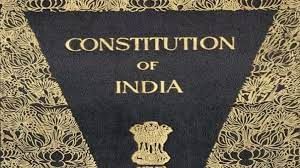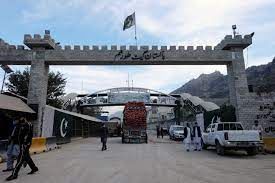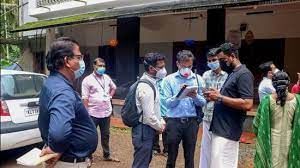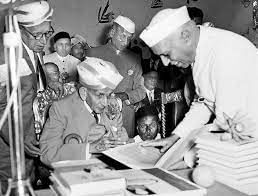UPSC Daily Current Affairs- 16th September 2023 | Current Affairs & Hindu Analysis: Daily, Weekly & Monthly PDF Download
GS-I
Pampaphoneus biccai
Subject: Geography

Why in News?
265-million-year-old fossil belongs to oldest, largest South American predator before dinosaurs.
About Pampaphoneus biccai:
- It belongs to the early therapsid clade called dinocephalians.
- It lived just before the largest extinction event in the history of Earth. That event eliminated 86 per cent of all animal species across the globe.
- Before the extinction event, dinocephalians were one of the major groups of large terrestrial animals that thrived on land.
- They were medium to large-sized creatures with both carnivorous and herbivorous representatives.
- They had thick cranial bones, which led to the group's name which translates to "terrible head" in Greek.
- These animals are rare in other parts of the world but well-known in South Africa and Russia.
- It is the only known species in Brazil.
Source: Indian Express
Bagmati River
Subject: Geography

Why in News?
At least 12 people went missing after a boat capsized in the Bagmati river in Muzaffarpur district of Bihar recently.
About
- Bagmati River is a transboundary river between the Nepal and India border.
- Origin: Shivapuri Hills to the north of Kathmandu, Nepal.
- Mouth of the River: The River ultimately joins the Narayani River. The merged waters of the Bagmati and Narayani eventually make their way southward and into the Ganges.
- Total length: 586.3 km.
- Tributaries:
- Bishnumati River
- Manohara River
- Dhobi Khola River.
- Significance:
- The Nepalese people believed that the Bagmati was the origin of their civilization and urbanization.
- Located on the river’s edge, the Pashupatinath Temple is an important Hindu pilgrimage site dedicated to Shiva.
Source: The Hindu
GS-II
In diverse India, name change demands consensus
Subject: Polity and Governance
Why in News?
The recent official invitation from Rashtrapati Bhavan referring to the President of India as the President of Bharat has ignited a fervent debate and raised questions about the country’s official nomenclature.
Central idea
- The controversy arises from the use of the term President of Bharat in the official invitation sent out by Rashtrapati Bhavan. Constitutionally, there is no provision for a president of Bharat. This seemingly innocuous change has triggered a larger conversation about the nation’s identity, politics, and historical context.
Historical Context
- Constituent Assembly Debates:
- During the Constituent Assembly’s deliberations for the Indian Constitution, the question of the country’s official name arose.
- Diverse opinions were expressed regarding whether to adopt Bharat or India as the preferred name.
- Preference for Bharat:
- Some constituent assembly members favored Bharat as the official name.
- They cited its deep-rooted historical and cultural significance, drawing from ancient Indian texts and traditions.
- Preference for India:
- Conversely, other assembly members leaned toward retaining ‘India’ as the official name.
- They argued that India was a name already recognized internationally, particularly during the colonial era.
- B.R. Ambedkar’s Compromise:
- To reconcile these differing views, B.R. Ambedkar, the chairperson of the drafting committee, introduced a compromise.
- He proposed the inclusion of Bharat in Article 1 of the Constitution to accommodate both names.
- Intent of the Compromise:
- The compromise aimed to respect the historical and cultural significance of ‘Bharat’ while preserving the international recognition of India.
- It sought to acknowledge linguistic diversity and cultural heritage within the constitutional framework.
Constitutional Perspective
- Official Nomenclature: President of India: Article 52 of the Indian Constitution clearly states that there shall be a President of India. This is the official nomenclature of the head of state as established by the Constitution.
- Article 1 of the Constitution: Article 1 of the Constitution reads, India, that is, Bharat, shall be a Union of States.
- Hindi Translation Clarification: The word Bharat is used in the Hindi translation of the Constitution, but it does not appear as an independent word in the original Constitution in languages other than Hindi.
- Clarificatory Phrase That is:
- The phrase that is in Article 1 is considered clarificatory, explaining or further clarifying the preceding word, India.
- Therefore, the interpretation is that Article 1 signifies that India, known as Bharat, shall be a Union of States.
- Translation as a Clarification:
- Article 394A (2) emphasizes that the translation of the Constitution is meant to have the same meaning as the original.
- This reinforces the point that Bharat is a translation of ‘India’ in the Hindi version, and India is the authentic name of the country unless changed through a legal process.
The potential ramifications of renaming India Bharat
- International Confusion: The use of Bharat alongside India in official communications may cause confusion in international diplomacy, trade agreements, and diplomatic relations as foreign governments and entities may encounter varying references.
- Legal Implications: Changing the country’s name could require the revision of existing laws, treaties, and agreements to accommodate the new name, potentially leading to complex legal challenges.
- Administrative Challenges: Renaming entails substantial administrative efforts, including updating official documents, government websites, passports, currency, and various bureaucratic aspects. This can result in logistical challenges and significant costs.
- Cultural and Historical Significance: India has deep cultural and historical significance, and changing it may disrupt these connections and create a sense of alienation among certain sections of the population.
- Unity and Inclusivity: Renaming should consider the sentiments of diverse communities within the country to maintain national unity and inclusivity. A hasty or unilateral decision could create divisions.
- Global Reputation: A country’s global reputation is closely linked to its name. Changing it can impact how the world perceives and interacts with the nation, potentially requiring time to establish a new global identity.
- Economic Impact: The renaming process can have economic consequences, including rebranding costs for businesses, potential disruptions in trade, and impacts on tourism and foreign investments.
Arguments Against the Rename
- Confusion in Official Communication: The potential for confusion arises if Bharat is used interchangeably with ‘India’ in official communication. Maintaining a single, consistent name is essential for clear diplomatic relations and international agreements.
- Official Name: Republic of India: The official name of the country is the Republic of India in official communication with foreign countries and international bodies. Using Bharat alongside India could lead to inconsistency and misunderstanding in international dealings.
- Foreign Government Confusion: Foreign governments might be perplexed if India is referred to differently in various agreements, sometimes as the Republic of India and sometimes as the Republic of Bharat.
Way forward
- Constitutional Clarity: Ensure any change in the official name of the country follows a formal constitutional amendment process. This requires an amendment to Article 1, which currently defines the country as India, that is, Bharat, which shall be a Union of States.
- Historical Context: Take into account the historical context and significance of the name India in the country’s identity. Recognize that India has historical continuity and international recognition.
- Linguistic Consistency: Recognize linguistic diversity within India while maintaining consistency across different languages and scripts used within the country. Bharat is primarily used in the Hindi version of the Constitution.
- International Relations: Consider the potential implications for India’s international relations and reputation. Maintain a single, consistent name in official communication with foreign countries and international bodies to avoid confusion and maintain diplomatic clarity.
- Public Sentiment: Engage with the public and seek their input and feedback on this significant decision. Public sentiment and consensus should be considered in any decision to change the official name.
- Historical Symbolism: Acknowledge that renaming may carry broader symbolism beyond a linguistic change. Addressing issues related to colonial symbols and administrative structures should be part of a comprehensive approach.
- Legislative Process: Follow the legislative process outlined in the Indian Constitution for any changes to the country’s name, ensuring transparency and adherence to constitutional principles.
Conclusion
- The controversy surrounding the use of Bharat in official communication requires constitutional clarity and consensus-building. In the spirit of Vasudhaiva Kutumbakam, it is essential to ensure that any changes reflect the unity and inclusivity that India stands for.
Source: The Hindu
Relevance of Constitution Benches in the Supreme Court
Subject: Polity and Governance

Why in News?
CJI D.Y. Chandrachud, took a moment to address a lawyer’s misconceptions regarding the purpose of Constitution Benches in the Supreme Court.
What is a Constitution Bench?
- The constitution bench is the name given to the benches of the Supreme Court of India.
- The Chief Justice of India has the power to constitute a Constitution Bench and refer cases to it.
Constitution benches are set up when the following circumstances exist:
- Interpretation of the Constitution: Article 145(3) provides for the constitution of at least five judges of the court which sit to decide any case “involving a substantial question of law as to the interpretation” of the Constitution of India.
- President of India seeking SC’s opinion: When the President has sought the Supreme Court’s opinion on a question of fact or law under Article 143 of the Constitution. Article 143 of the Constitution provides for Advisory jurisdiction to the SC. As per the provision, the President has the power to address questions to the apex Court, which he deems important for public welfare.
- Conflicting Judgments: When two or more three-judge benches of the Supreme Court have delivered conflicting judgments on the same point of law, necessitating a definite understanding and interpretation of the law by a larger bench.
- The Constitution benches are set up on ad hoc basis as and when the above-mentioned conditions exist.
- Constitution benches have decided many of India’s best-known and most important Supreme Court cases, such as:
- K. Gopalan v. State of Madras, 1950 (Preventive detention)
- Ashoka Kumar Thakur v. Union of India, 1972 (OBC reservations) etc.
- Kesavananda Bharati v. State of Kerala, 1973 (Basic structure doctrine) and
Critique and Response
- A Lawyer’s Concern: A litigant had expressed concerns in a letter to the top court’s Secretary General, suggesting that the court was investing excessive time in Constitution Bench cases, neglecting public interest petitions that directly impact common individuals.
- Court’s Defense: CJI challenged this notion, emphasizing that not all Constitution Bench cases revolve around the interpretation of the Constitution.
- Examples Matter: He provided an example of a recent Constitution Bench case concerning whether a person holding a light motor vehicle license can operate a commercial vehicle. This directly affects the livelihood of countless drivers across the nation.
CJI Dispelling Misconceptions
- Not Just “Fancy” Matters: CJI clarified that the Supreme Court doesn’t convene Constitution Benches solely for matters detached from the everyday concerns of ordinary citizens.
- Voice of the Nation: He highlighted instances like the Article 370 abrogation challenge, where the court engaged with the “voice of the nation.” Stakeholders from the Valley actively participated in extensive hearings.
Arguments against such hearings
- People’s Perspective: The Advocate clarified that his objection wasn’t against the court hearing Constitution Bench matters but rather the court’s engagement in public policy issues without adequate public input.
- Court’s Response: CJI countered this argument, citing the Article 370 case as an example where groups of individual interveners from the Valley actively presented their perspectives to the court.
Conclusion
- Balancing Act: CJI’s remarks underscore the delicate balance between addressing constitutional matters and matters of public interest, highlighting that both have their place in the Supreme Court’s agenda.
- Inclusive Justice: The exchange between the Chief Justice and the lawyer reflects the importance of ensuring that the court’s decisions consider the perspectives and concerns of the broader public, especially in cases with significant societal impact.
Source: Times of India
Afghan-Pakistan Torkham Border
Subject: International Relations

Why in News?
Afghan-Pakistan Torkham border clashes intensify as Taliban builds a border post on Pakistan soil.
About Torkham Crossing
- The Torkham Crossing, a critical border point connecting Pakistan and Afghanistan.
- Torkham Crossing is a crucial border crossing that links Pakistan and Afghanistan. Its strategic location makes it a vital entry point for trade and connectivity between the two nations.
- The Border road is a key lifeline for a landlocked Afghanistan, linking the northwestern Pakistani city of Peshawar to Jalalabad, the main city in Nangarhar, and the route onwards to the capital Kabul.
Durand Line
- It is an important international boundary line between Pakistan and Afghanistan.
- The Durand Line was drawn up by Sir Henry Mortimer Durand, a British diplomat, to safeguard the interests of the British Empire from Tsarist Russia.
- The single-page Durand Line Agreement was signed by the King of Afghanistan, Amir Abdur Rahman, in November 1893.
- The line was drawn up to ensure that strategic regions such as the Khyber Pass remained on the side of the British Empire.
Why does Afghanistan oppose the Durand Line?
- Afghanistan claims that British India unilaterally imposed the line on Rahman, and divided families, referring to the Pashtuns — Afghanistan’s largest ethnic group and the key to any regime seeking legitimacy.
- When Pakistan was created in 1947 and inherited the Durand Line, Afghanistan questioned the legality of the Durand Line Agreement as it had been signed with the British Crown and ought to have lapsed at independence.
Source: The Hindu
GS-III
K2-18b Exoplanet
Subject: Science and Technology

Why in News?
NASA's James Webb Space Telescope may have found signs of life on exoplanet K2-18b through the detection of dimethyl sulphide (DMS).
About K2-18b Exoplanet:
- It was first discovered in 2015 more than 120 light-years from Earth during the space agency's K2 mission.
- It is 8.6 times bigger than Earth.
- It could be a "Hycean" world with a hydrogen-rich atmosphere and a surface covered by ocean water.
- Now, a new investigation with the Webb telescope has revealed traces of carbon-bearing molecules in its atmosphere, including methane and carbon dioxide.
Key points about the James Webb Space Telescope
- This telescope was built in collaboration between NASA, the European Space Agency (ESA) and the Canadian Space Agency.
- It was launched in December 2021.
- It is presently at a point in space known as the Sun-Earth L2 Lagrange point, approximately 1.5 million km beyond Earth’s orbit.
- Lagrange Point 2 is one of the five points in the orbital plane of the Earth-Sun system.
- It's the largest, most powerful infrared space telescope ever built.
- Objectives: It will examine every phase of cosmic history; from the Big Bang to the formation of galaxies, stars, and planets to the evolution of our Solar System.
Source: Mint
Monoclonal Antibody for Nipah
Subject: Science and Technology
Why in News?
India has reached out to Australia in its efforts to procure monoclonal antibody doses for combating the Nipah virus outbreak in Kerala.
- The monoclonal antibody has successfully passed phase-one trials and has been administered to 14 individuals globally.
Why use it for Nipah?
- Currently, there is no effective treatment for Nipah virus infection apart from symptom relief.
- The virus carries a high mortality rate ranging from 40% to 75%, making it a formidable threat.
- In comparison, even during the peak of the Covid-19 pandemic, the case fatality ratio (CFR) remained at around three percent.
What are Monoclonal Antibodies (mAbs)?
- Monoclonal antibodies (mAbs) are a class of therapeutic proteins that have revolutionized medicine and healthcare.
- They are used in a wide range of applications, from treating diseases to diagnosing conditions and conducting scientific research.
Structure of mAbs
- Monoclonal antibodies are proteins produced by a single type of immune cell, known as a B cell.
- They are called “monoclonal” because they are derived from a single, cloned parent cell.
- These antibodies have a specific Y-shaped structure consisting of two identical heavy chains and two identical light chains.
- The variable region of the antibody binds to a specific antigen with high precision.
Applications of Monoclonal Antibodies
- Monoclonal antibodies have a wide range of applications in medicine, science, and diagnostics:
- MAbs are used to treat various diseases, including cancer, autoimmune disorders, infectious diseases, and more.
- They are used in diagnostic tests, such as ELISA (enzyme-linked immunosorbent assay), to detect specific molecules like antigens or antibodies.
- Scientists use mAbs to study and manipulate biological processes. They can be labeled with fluorescent markers for imaging and are crucial tools in cell biology and molecular biology research.
- Monoclonal antibodies labelled with radioactive isotopes or fluorescent markers can be used for diagnostic imaging techniques like PET (positron emission tomography) scans.
- They can target specific molecules on cancer cells, minimizing damage to healthy cells during cancer treatment.
Challenges and Advancements
- Despite their significant benefits, monoclonal antibodies can have limitations, such as high production costs and the potential for immune responses.
- Advances in technology, such as the development of humanized antibodies (antibodies with human components to reduce immune reactions), have addressed some of these challenges.
Source: The Hindu
M Visvesvaraya: India’s pioneering Civil Engineer
Subject: Science and Technology

Why in News?
September 15 marks the birthday of Sir Mokshagundam Visvesvaraya (1861-1962), celebrated for his pivotal role as a civil engineer and administrator during colonial India.
About M. Visvesvaraya
- Early life: Born on September 15, 1861, in the village of Muddenahalli, Karnataka, Visvesvaraya commenced his educational journey in his hometown.
- Academic Pursuits: He pursued a Bachelor of Arts degree at the University of Madras and later embarked on a diploma course in civil engineering at the College of Science in Pune.
Career Achievements
- Engineering Pioneer: After completing his engineering studies at Poona College of Science, Visvesvaraya commenced his career as an Assistant Engineer in the Public Works Department (PWD) of the Government of Bombay at the age of 22.
- Notable Projects: Among his initial projects was the construction of a pipe syphon across one of Panjra river’s channels.
- Dewan of Mysore: In 1909, he assumed the role of Chief Engineer in the Mysore service, eventually becoming the 19th Dewan of Mysore.
- Voluntary Retirement: In 1918, Visvesvaraya took voluntary retirement due to his disagreement with the proposal to allocate state jobs based on caste.
- Committees and Contributions: Following retirement, he chaired or participated in various committees, including the Bombay Technical and Industrial Education Committee, Bombay University Committee for Promoting Chemical Industries, and the Cauvery Canal Committee.
Significant Works
- Block System of Irrigation: In 1899, he introduced the block system of irrigation in the Deccan canals, enhancing the equitable distribution of irrigation benefits among numerous villages.
- Water Quality Improvement: Visvesvaraya tackled the issue of “muddy and discolored” water in Sukkur, a city on the banks of the Indus River.
- Invention of Automatic Gates: He invented automatic gates for regulating water flow in reservoirs, securing a patent for this innovation.
- Implementation at Krishnaraja Sagar Dam: The Krishnaraja Sagar Dam in Karnataka became the first to adopt these gates in the 1920s.
Global Perspective
- International Learning: Visvesvaraya travelled abroad to study various aspects of other countries’ systems. During a visit to Italy, he examined soil erosion problems and irrigation and drainage works.
- Advocating for Indian Contributions: He challenged the perception that only British officers were capable of overseeing advanced engineering works, emphasizing that Indian expertise was valuable when supported by qualifications and dedication.
Vision for Progress
- Inspirational Speech: In a speech delivered on March 16, 1912, at Central College Bangalore, Visvesvaraya emphasized the need for India to adopt modern practices, scientific precision, inventiveness, discipline, and economic fundamentals for progress.
- Promoting Self-Examination: He encouraged a secular self-examination, comparing local conditions in India with global counterparts.
- Authorship: Visvesvaraya authored two influential books, “Reconstructing India” (1920) and “Planned Economy of India” (1934).
Impact on Education
- Education as a Catalyst: Visvesvaraya recognized the critical role of education in shaping an economy during his visit to Japan in 1898.
- Founding the University of Mysore: As the Dewan of Mysore in 1916, he played a pivotal role in establishing the University of Mysore, emphasizing that educational institutions should mirror real-life conditions.
Source: Indian Express
|
38 videos|5293 docs|1118 tests
|
FAQs on UPSC Daily Current Affairs- 16th September 2023 - Current Affairs & Hindu Analysis: Daily, Weekly & Monthly
| 1. What is Pampaphoneus biccai? |  |
| 2. What is the Bagmati River? |  |
| 3. Why is consensus required for name changes in diverse India? |  |
| 4. What is the relevance of Constitution Benches in the Supreme Court? |  |
| 5. What is the significance of the Afghan-Pakistan Torkham Border? |  |
















